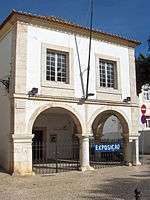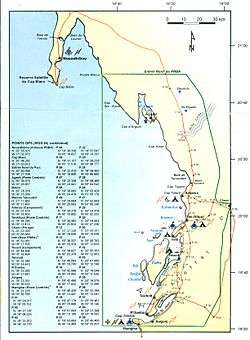Lançarote de Freitas
Lançarote de Freitas, better known as Lançarote de Lagos or Lançarote da Ilha, was a 15th-century Portuguese explorer and slave trader from Lagos, Portugal. He was the leader of two large Portuguese slaving raids on the West African coast in 1444-1446.
Background

Lançarote de Freitas (better known simply as Lançarote de Lagos) was trained as a squire and chamberlain in the household of the Portuguese prince Henry the Navigator. Sometime in the 1430s or early 1440s, Lançarote was appointed by Henry as almoxarife (customs-collector) of Lagos, Portugal.
The naval expeditions that Henry the Navigator had been sending down the West African coast since at least the early 1430s had, during their first few years, yielded little profit. They had sailed mostly along the Sahara desert coast, with no native settlements in sight or encounters worth reporting. But in 1443, one of Henry's captains, Nuno Tristão, returned from an expedition with some 14 captive African natives, Sanhaja Berbers seized from small native fishing settlements he found in the Bay of Arguin. The prospect of easy and profitable slave-raiding grounds around the Arguin banks aroused the interest of numerous Portuguese merchants and adventurers.
That same year (1443), the regent prince Peter of Coimbra granted his brother Henry the Navigator an exclusive monopoly on all trade south of Cape Bojador. A consortium of merchants of Lagos, sometimes referred to as the Companhia de Lagos ('Lagos Company', although it was probably little more than a temporary association of merchants, rather than an incorporated company in the proper sense), applied to Henry for a license. Possibly on account of his intimate relationship with Henry, the Lagos merchants elected Lançarote as their head.
First Slave Raid (1444)

Having acquired their license, the Lagos company equipped a fleet of six ships and about thirty men that set out for the Arguin banks in the Spring of 1444. The six captains are normally recorded as:[1]
- 1. Lançarote de Freitas
- 2. Gil Eanes
- 3. Estêvão Afonso
- 4. Rodrigo Álvares
- 5. João Dias
- 6. uncertain (variously given as Martim Vicente, Gil Vasques, João Bernaldez or even Gonçalo de Sintra).
Lançarote's fleet headed straight to the southern end of the Arguin Bay, where they had been told by Nuno Tristão's captives that populous fishing settlements could be found. A pre-dawn raid on Nar (Nair island) yielded the first set of captives. This was followed up by raids on the larger neighboring island of Tider (Tidra island) and Cerina (Serenni peninsula). In just a few days, the Lagos fleet had taken some 235 hapless Berber natives captive. The remaining population having fled the coastal settlements and hidden in the hinterlands, there was little point remaining in the area. By August, the fleet had arrived back in Lagos with their human cargo.
The spectacle of the disembarkation, partition and sale of the Arguin slaves in Lagos, in the presence of Prince Henry, mounted on his horse, is described in heart-breaking detail in Zurara's Crónica.[2] For this lucrative enterprise, Lançarote was knighted by Henry on the spot (even though, according to Zurara, Henry gave away his own allotment - some 46 slaves, to which he was entitled as licenser of the expedition - among his captains and household servants).
Second Slave Raid (1445/1446)
Lançarote organized a second Lagos fleet for another large slave raid in 1445 (or 1446).[3] The Lagos fleet was composed of 14 ships, the captains normally given as:[4]
- 1. Lançarote de Freitas
- 2. Soeiro da Costa (alcaide of Lagos and Lançarote's father-in-law)
- 3. Álvaro de Freitas (probably a relative of Lançarote)
- 4. Gomes Pires (captain of the king's caravel)
- 5. Rodrigo Eanes Travassos (of the household of the regent Peter of Coimbra),
- 6. a knight known as Palançano (aboard a fusta)
- 7. Vicente Dias of Lagos
- 8. Martim Vicente
- 9. a captain nicknamed Picanço (speculated to be Diogo Gomes)
- 10. Lourenço Dias
and, more speculatively:
- 11. Diogo Gonçalves,
- 12. Pedro Alemão,
- 13. Gil Gonçalves,
- 14. Leonel Gil (son of Gil Eanes).
This fleet is said to have carried Gil Eanes and Estêvão Afonso as passengers.[5]
Setting out in August, 1445 (or 1446), Lançarote's Lagos fleet was just one of several fleets that set out from Portugal for the Arguin banks that year. Caught by bad weather, Lançarote arrived at Cape Blanc with only nine ships still together, the remaining having strayed off. He proceeded to the northern end of the Arguin banks, anchoring in at ilha das Graças (uncertain, possibly Madeleine island or Pelicans island). There, Lançarote was met by one of his missing ships, Vicente Dias, who had gone on ahead to Arguin island and stumbled across a small fleet of three Lisbon ships, headed by Dinis Eanes de Grã, who had preceded them and devastated the remaining settlements on the northern end of the bay, taking some 100 captives. At Grã's suggestion, Lançarote's fleet, now thirteen strong (only Palançano's fusta remained unaccounted for) attacked Arguin island again (taking 4 captives), then headed to the southern end of Arguin Bay, taking 57 captives at Tider and an additional 5 somewhere further down (possibly around Cape Timris). The element of surprise being gone and the bulk of the population having already evacuated the coast, Lançarote's captives were principally Sanhaja Berber tribesmen who had decided to stay and put up a fight.[6]
Dissatisfied with the meager number of captives and realizing that Arguin Bay was too thoroughly deserted to yield up any more, Lançarote decided to take his fleet south to raid the Wolof lands of Senegal, which had been discovered (but not yet raided) by Nuno Tristão and Dinis Dias the previous year. However, not all his ships were up for the journey, several of them running short on supplies. As a result, Lançarote partitioned his fleet, taking only six or seven caravels with him, sending the remaining ships back to Lagos under the command of Soeiro da Costa (a few of which would conduct an unauthorized slave raid on the Canary islands of La Palma and Gomera on their way home).
Lançarote's squadron soon arrived at Barbary Point, the mouth of the Senegal River, which was as yet unexplored.[7] He dispatched Estêvão Afonso on a launch to search upriver for settlements. The exploration didn't get very far. Venturing ashore at one point along the river bank, Afonso abducted two Wolof children from a local woodsman's hut, only to be chased down and furiously beaten by their father. Having barely escaped with their lives, the launch immediately returned to the waiting caravels.[8]
After sending back yet another caravel to Lagos, Lançarote proceeded with his five remaining ships around Cape Vert into Dakar Bay. The squadron landed in the island of Bezeguiche (Gorée island), where they found a marker left behind by Álvaro Fernandes, a Portuguese explorer from Madeira who had preceded them there only a few weeks earlier.[9] Fernandes had attempted to take a few Wolof canoes captive, with the result that the Wolof tribesmen of the mainland were already alert and in arms against the arriving ships. Not quite realizing this, Lançarote sent out Gomes Pires on a launch to the mainland to open contact with the local Wolof chieftains, but Pires's approach was prevented by a hail of arrows.
His first strategy foiled, Lançarote ordered the Portuguese to prepare a raid on the mainland Wolof villages 'in the style of Arguin', but this came to nought. Before being able to organize the attack, a sudden storm enveloped the area, and forced the Portuguese caravels out of Bezeguiche bay, scattering them in various directions.
Lançarote managed to hold two other caravels (Álvaro de Freitas and Vicente Dias) together with him, but lost sight of the other two. Realizing they were now too few to launch an attack on the Wolof mainland, Lançarote's trio set sail back to the Arguin banks, where they anchored in at Tider and took an additional 59 captives, before returning to Lagos. The remaining two ships (Lourenço Dias and Gomes Pires) made their way back to Portugal by themselves (Pires making a brief stop in Cape Blanc, to buy some seal pelts and slaves from some Berber traders).[10]
Little more is heard about Lançarote de Lagos. In number of captives, the 1445/6 slaving expedition had been somewhat of a disappointment (at least relative to the first 1444 expedition). The prospect for future slave raids seemed dim. The Arguin banks were devastated and it was unlikely the Berber populations would return to the coasts in significant numbers, or allow themselves to be taken by surprise. The Wolof-dominated coasts of Senegal were too strong and alert for small groups of venturing Portuguese slave-raiders. If slave raids were to have any prospect of success, the element of surprise was necessary, which now meant sailing well below Senegal to new 'hunting grounds' - lengthier expeditions which required probably more supplies and capital than what Lagos merchants were willing to front or captains willing to sail. The killing of Nuno Tristão and his crew the next year (1446 or 1447) probably dampened any remaining enthusiasm among Lagos merchants for renewing the slave raids.
Notes
- Zurara (p.60-86), Barros (p.65), Quintella (p.106), Diffie and Winius (p.80-81)
- Zurara, p.79-86
- Cortesão (p.18) and Diffie and Winius (p. 84, p. 467), following Zurara, place this in 1445. Quintella (p.139), following Barros, places it in 1446. Faria e Sousa (527-28) places it in 1447.
- This list is drawn mainly from Faria e Sousa (p.527) Both Zurara (p.152) and Barros (p.85-86) explicitly mention only 1-6 in their lists, referring to the rest merely as 'other honorable persons of Lagos'. However, some names, e.g. Lourenço Dias and Vicente Dias, are mentioned later in their narratives.
- Zurara (p.152).
- Zurara (p.161-71), Barros (p.88-91), Quintella (p.140-41)
- Zurara (p.176, p.183ff.)
- Zurara (p.178-83), Barros (p.110-12), Quintella (p.144-45)
- Zurara (p.192), Barros (p.113), Quintella (p.145)
- Zurara (p.193-94), Barros (p.115), Quintella (p.146)
Sources
- João de Barros (1552–59) Décadas da Ásia: Dos feitos, que os Portuguezes fizeram no descubrimento, e conquista, dos mares, e terras do Oriente. Vol. 1 (Dec I, Lib.1-5)
- Gomes Eanes de Zurara (1453) Crónica dos feitos notáveis que se passaram na Conquista da Guiné por mandado do Infante D. Henrique or Chronica do descobrimento e conquista da Guiné. [Trans. 1896-99 by C.R. Beazley and E. Prestage, The Chronicle of the Discovery and Conquest of Guinea, London: Halykut]
- Cortesão, Armando (1931) "Subsídios para a história do Descobrimento de Cabo Verde e Guiné", Boletim da Agencia Geral das Colonias, No. 75. As reprinted in 1975, Esparsos, vol. 1, Coimbra
- Diffie, Bailey W., and George D. Winius (1977) Foundations of the Portuguese empire, 1415-1580 Minneapolis, MN: University of Minnesota Press
- Manuel de Faria e Sousa (1675) ""Empieça la Memoria de todas las Armadas", in Asia Portuguesa, Vol. 3, p.525-61
- Quintella, Ignaco da Costa (1839–40) Annaes da Marinha Portugueza, 2 vols, Lisbon: Academia Real das Sciencias. vol. 1